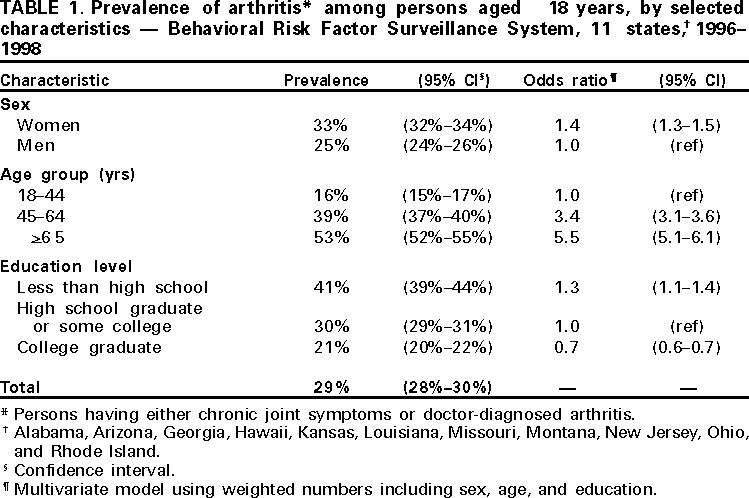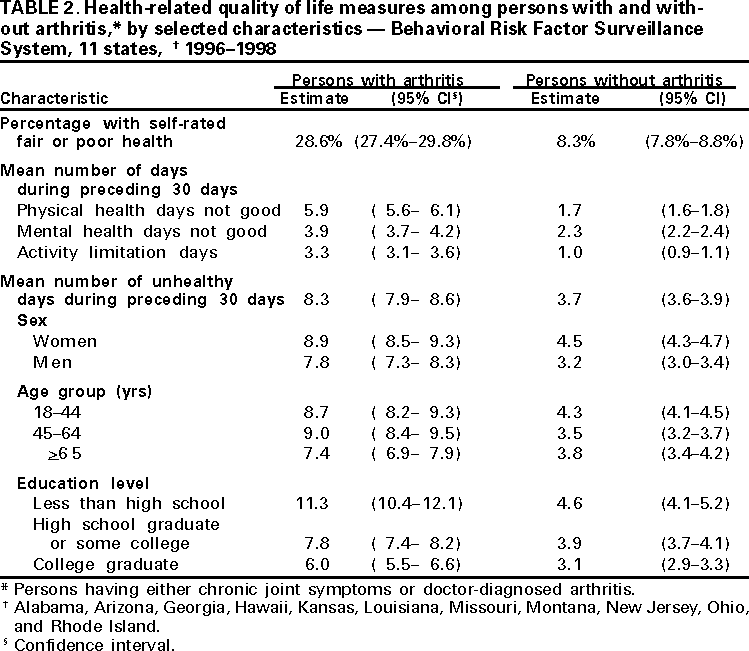 |
|
|
|
|
|
|
|
|
|
|
|
|
|
|
|
|
||||
| ||||||||||
|
|
|
|
Health-Related Quality of Life Among Adults With Arthritis --- Behavioral Risk Factor Surveillance System, 11 States, 1996--1998Arthritis and other rheumatic conditions are the leading cause of disability in the United States (1), affecting 43 million persons in 1998 and---with the aging of the "baby boom" generation---are projected to affect an estimated 60 million by 2020 (2). In 1992, these conditions cost $65 billion in medical care and lost productivity (3) and were associated with 744,000 hospitalizations and 44 million ambulatory-care visits in 1997 (4). Because arthritis and other rheumatic conditions seldom cause death but have a substantial impact on health, health-related quality of life (HRQOL) measures are better indicators of their impact than related mortality rates. This report examines data from 11 states* that included an arthritis module in the 1996--1998 Behavioral Risk Factor Surveillance System (BRFSS); findings indicate that persons with arthritis have worse HRQOL than persons without arthritis, regardless of sex, age, or education level. BRFSS is an ongoing state-based, random-digit--dialed telephone survey of the civilian, noninstitutionalized population aged >18 years (5). Four standard BRFSS questions defined the HRQOL measures (general self-rated health and the number of days during the 30 days preceding the survey when physical health was not good, mental health was not good, or usual activities were limited). Unhealthy days were defined as the total number of days when physical health and/or mental health were not good, with the restriction that this total could not exceed 30 days. Responses to the HRQOL questions were analyzed for 32,322 persons from the 11 states that used a six-item optional BRFSS arthritis module during 1996--1998. Persons with arthritis were defined as those having either chronic joint symptoms (CJS) or doctor-diagnosed arthritis. Persons were considered to have CJS if they responded "yes" to the questions "During the past 12 months, have you had pain, aching, stiffness, or swelling in or around a joint?" and "Were these symptoms present on most days for at least 1 month?" Persons who responded "yes" to the question "Have you ever been told by a doctor that you have arthritis?" were defined as having doctor-diagnosed arthritis. All other respondents were defined as persons without arthritis. The analyses used sample weights and SUDAAN statistical software to account for the complex survey design; selected analyses were adjusted for the potentially confounding effects of sex, age, and education level (6,7). In the 11 states, 9899 (29%) persons reported having arthritis; 7414 (75%) had doctor- diagnosed arthritis. The age-adjusted (1970 U.S. population) prevalence varied by state and year, ranging from 24.2% to 35.1% in 1996, 17.7% to 30.9% in 1997, and 26.2% to 33.8% in 1998. The unadjusted prevalence of arthritis was higher among women than men, increased with age, and decreased at higher education levels; these differences persisted in a multivariate model with adjustments for sex, age, and education (Table 1). Respondents with arthritis reported having fair or poor health approximately three times more often than respondents without arthritis (Table 2). Compared with persons without arthritis, persons with arthritis averaged 4.2 more days when physical health was not good, 1.6 more days when mental health was not good, 4.6 more unhealthy days, and 2.3 more days of recent activity limitation because of poor physical or mental health during the 30 days preceding the survey (p-values <0.01). These estimates did not change after adjusting for sex, age, and education level. During the 30 days preceding the survey, women with arthritis had an average of 4.4 more unhealthy days than women without arthritis, and men with arthritis had an average of 4.6 more unhealthy days than men without arthritis (Table 2). Among the three age groups, adults with arthritis had an average of 3.6 to 5.5 more unhealthy days than adults without arthritis. Among three education levels, adults with arthritis had an average of 2.9 to 6.7 more unhealthy days than adults without arthritis (p-values <0.01). These estimates did not change after adjusting for sex, age, and education. Reported by the following BRFSS coordinators: S Reese, MPH, Alabama; B Bender, MBA, Arizona; L Martin, MS, Georgia; F Reyes-Salvail, MS, Hawaii; C Hunt, MPH, Kansas; B Bates, MSPH, Louisiana; T Murayi, PhD, Missouri; P Feigley, PhD, Montana; G Boeselager, MS, New Jersey; P Pullen, Ohio; J Hesser, PhD, Rhode Island. Health Care and Aging Studies Br, Div of Adult and Community Health, National Center for Chronic Disease Prevention and Health Promotion, CDC. Editorial Note:The findings in this report indicate that persons with arthritis have substantially worse HRQOL than persons without arthritis. Among adults with arthritis, the largest number of unhealthy days was experienced by women, younger persons, and persons with less than a college education; among women and young persons, this was associated with more bad mental health days. Depression is common in persons with all types of arthritis and other rheumatic conditions, but depression is most clearly documented among persons with rheumatoid arthritis (8). Among persons with less than a college education (an indicator for socioeconomic status), more unhealthy days may reflect less access to health-care services or more physical labor that may lead to more symptomatic disease. The findings in this report are subject to at least six limitations. First, because BRFSS does not ask about other common chronic conditions that affect HRQOL, this analysis could not adjust for these conditions in the study for comparison groups. Second, the BRFSS case definition for arthritis has not been validated, although validation studies are under way. However, in this report, the definition of "persons with CJS or doctor-diagnosed arthritis" may better identify those with arthritis and other rheumatic conditions because it is more comprehensive than a previous case definition that included only persons with CJS (6). Third, unhealthy days may be overestimated for persons who report both physical and mental unhealthy days when these days overlap. Fourth, because BRFSS excludes persons without telephones, those in institutions (e.g., nursing homes and the military), and persons aged <18 years, the arthritis prevalence rates do not represent the entire population. Fifth, the time and functional capacity required to complete BRFSS may limit participation by persons with arthritis who have poor health and limited function. Finally, the states participating in the BRFSS arthritis module may not be representative of other states. This analysis shows that adults with arthritis report 4.6 more unhealthy days (a validated measure of HRQOL) compared with those without arthritis. The millions of persons who are affected by arthritis are the target for interventions to improve HRQOL. The National Arthritis Action Plan (NAAP)---A Public Health Strategy (9) identifies available but underused interventions, such as the Arthritis Self-Help Course, which helps persons to decrease their pain and number of physician visits. The Arthritis Foundation estimates that these interventions reach <1% of the target population (9). State and local health agencies should consider using data from the BRFSS arthritis module and HRQOL measures to guide efforts in reaching the Healthy People 2010 goal of increasing the quality and years of healthy life for persons with arthritis (10). References
* Alabama, Arizona, Georgia, Hawaii, Kansas, Louisiana, Missouri, Montana, New Jersey, Ohio, and Rhode Island. Table 1  Return to top. Table 2  Return to top. Disclaimer All MMWR HTML versions of articles are electronic conversions from ASCII text into HTML. This conversion may have resulted in character translation or format errors in the HTML version. Users should not rely on this HTML document, but are referred to the electronic PDF version and/or the original MMWR paper copy for the official text, figures, and tables. An original paper copy of this issue can be obtained from the Superintendent of Documents, U.S. Government Printing Office (GPO), Washington, DC 20402-9371; telephone: (202) 512-1800. Contact GPO for current prices. **Questions or messages regarding errors in formatting should be addressed to mmwrq@cdc.gov.Page converted: 5/4/2000 |
|||||||||
This page last reviewed 5/2/01
|